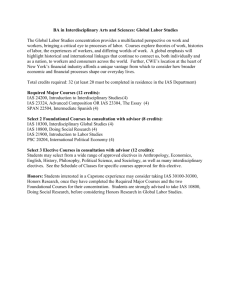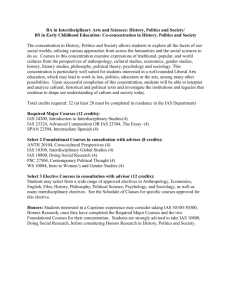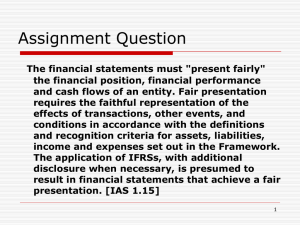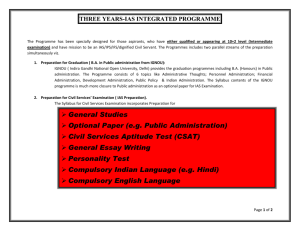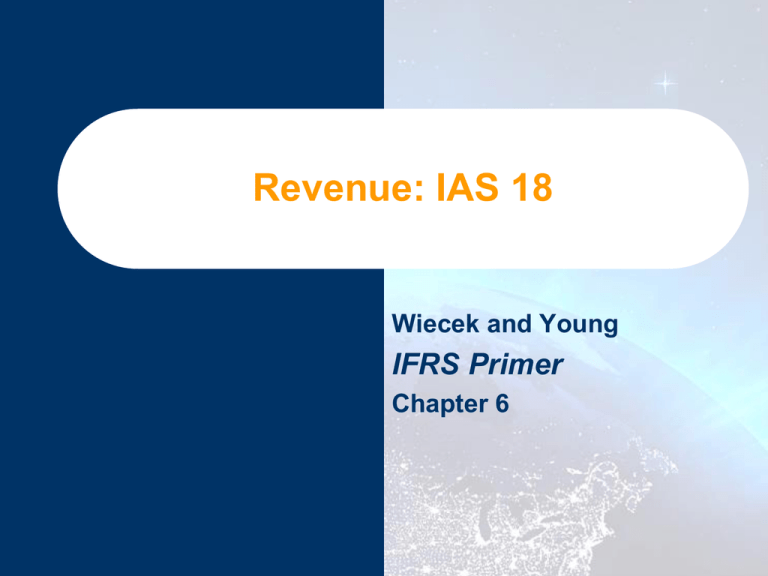
Revenue: IAS 18
Wiecek and Young
IFRS Primer
Chapter 6
Revenue
2
Related standards
IAS 18
Current GAAP comparisons
IFRS financial statement disclosures
Looking ahead
End-of-chapter practice
Related Standards
3
SAB 104 Revenue Recognition
SOP 81-1 Accounting for Performance of Construction-Type and Certain Production-Type
Contracts
SOP 97-2 Software Revenue Recognition
SOP 98-9 Software Revenue Recognition, with Respect to Certain Transactions
FAS 45 Accounting for Franchise Fee Revenue
FAS 48 Revenue Recognition When Right of Return Exists
FAS 49 Accounting for Product Financing Arrangements
FAS 66 Accounting for Sales of Real Estate
EITF 99-19 Reporting Revenue Gross as a Principal Versus Net as an Agent
EITF 00-21 Revenue Arrangements with Multiple Deliverables
EITF 00-22 Accounting for ‘Points’ and Certain Other Time-Based or Volume-Based Sales
Incentive Offers, and Offers for Free Products or Services to be Delivered in the Future
EITF 01-9 Accounting for Consideration Given by a Vendor to a Customer
CON 5 Recognition and Measurement in Financial Statements of Business Enterprises
CON 6 Elements of Financial Statements
Related Standards
4
IFRS 4 Insurance Contracts
IAS 11 Construction contracts
IAS 17 Leases
IAS 28 Investments in Associates
IAS 39 Financial Instruments: Recognition and
Measurement
IAS 41 Agriculture
IAS 18 – Overview
5
Objective and scope
Measurement of revenue
Identification of the transaction
Sale of goods
Rendering of services
Interest, royalties, and dividends
Disclosure
IAS 18 – Objective and Scope
6
IAS 18 deals with the recognition and measurement of revenues
Revenues are generated by ordinary business activities such as:
– Sale of goods
– Sale of services
– Fees
– Interest
– Royalties
– Dividends and other sources
According to IAS 18.6, the following are examples of items scoped
out of the standard:
– Lease agreements
– Changes in the value of other current assets
– Extraction of mineral ores
IAS 18 – Objective and Scope
7
The IAS framework defines income to include both revenues and gains
IAS 18.7 provides the following definition of revenue:
“Revenue is the gross inflow of economic benefits during the period arising
in the course of the ordinary activities of an entity when those inflows result
in increases in equity, other than increases relating to contributions from
equity participants”
It is important to separate income from ordinary activities and income from
atypical/infrequent activities since many users use the financial statements
to assess the nature, timing, and amount of future earnings and cash flows
Income from ordinary activities is more likely to recur than income from
atypical/infrequent activities
IAS 18 – Measurement of Revenue
Revenue is measured at the fair value of the
consideration received or receivable
Fair value is defined in IAS 18.7 as follows:
“Fair value is the amount for which an asset could
be exchanged, or a liability settled, between
knowledgeable, willing parties in an arm’s length
transaction”
8
IAS 18 – Measurement of Revenue
AMOUNTS PAID OVER TIME:
9
The fair value is the amount of cash or cash equivalents received
When the amount due is paid over time, the cash flows are discounted using:
• a discount rate that reflects either the prevailing rate for a similar instrument, or
• an imputed rate of interest that equates the receivables to the current cash
sales price
The choice of interest rate should reflect the riskiness of the cash flows.
– Generally, with sales, the amount and timing of the receivables is fixed,
although there will often be credit risk attached to the cash flow stream
– The discount rate might therefore reflect the customer’s incremental
borrowing rate
An alternate view is to impute an interest rate.
– If we know the cash selling price and the total cash flows to be paid under the
arrangement, the difference should theoretically be interest
IAS 18 – Measurement of Revenue
BARTER TRANSACTIONS:
Barter transactions that deal with items that are similar in nature and value are
not accounted for as revenues
–
–
If the goods are dissimilar, it is considered to be a sale and recorded as
revenues
–
–
10
The standard contemplates situations where commodities like oil or milk might
be exchanged by suppliers to facilitate customer sales
The substance of this type of transaction is that it is more like a loan of the
commodity by one supplier to the other, which will be repaid when the supplier
who borrowed the commodity returns it
The entity has transferred the risks and rewards of the one asset (a sale)
and taken on new and different risks and rewards for the other asset (a
purchase)
The transaction is measured at the fair value of the asset received unless it
cannot be reliably measured, in which the fair value of the asset given up is
used
IAS 18 – Measurement of Revenue
BARTER TRANSACTIONS (continued):
11
Barter transactions involving an exchange of advertising services are dealt
with separately
Barter transactions involving advertising may result in revenue recognition
as long as the advertising services provided and received are different
The problem arises with measurement
Although it may be difficult to measure the services received, the entity
may be able to measure the services rendered by looking at similar
advertising contracts that occur frequently and represent a predominant
number of transactions involving cash or cash-like consideration with
other parties
Thus, these transactions may be measured based on the fair value of the
services provide
IAS 18 – Identification of the Transaction
In order to understand how to account for a transaction, we must
understand the substance of the business transaction
In many cases, the transaction involves a collection of items or a bundle
–
–
12
Because the revenue recognition points may be different depending on
the asset sold or service rendered, we must break the transaction down
into separately identifiable components
Each component is then accounted for separately
The standard does not give concrete guidance as to how to divide the
transaction into separate units so judgment must be used
IAS 18 – Sale of Goods
Criteria for recognition of revenue for the sale of goods are as
follows (all criteria must be met):
(a) Significant risks and rewards of ownership are transferred
(b) Neither continuing managerial involvement nor effective control over the
goods sold is retained
(c) The amount of revenue is reliably measurable
(d) The economic benefits are probable and
(e) The costs are reliably measurable
For most sale of goods transactions, there is a critical event where the
risks and rewards pass from the seller to the buyer (this is normally the
point at which the legal title and possession pass)
–
–
13
In certain cases, either risks or rewards (but not both) will pass
Judgment must be used in determining what the substance of the
transaction is and whether significant risks and rewards have been
transferred
IAS 18 – Sale of Goods
If significant risks and rewards are retained or there is continuing managerial
involvement, revenue is not recognized
This may be the case for instance:
(a) If an obligation for unsatisfactory performance is retained
(b) If the receipt of revenue is contingent upon resale of the goods by the buyer
(c) If the goods must be installed and the installation is a significant part of the
contract and
(d) If the buyer can rescind the contract or back out of it and there is uncertainty
relating to the probability of this
14
Where there are insignificant risks and rewards or continuing managerial
involvement, it may be okay to recognize revenues
Judgment is used to determine significant versus insignificant
IAS 18 – Sale of Goods
15
Excerpts of Illustration 6-1:
IAS 18 – Sale of Goods
16
IAS 18 – Rendering of Services
The criteria for recognition of service revenues is as follows:
(a) Revenue is reliably measurable
(b) Economic benefits are probable
(c) Stage of completion reliably measurable and
(d) Costs reliably measurable.
PERCENTAGE OF COMPLETION METHOD VERSUS OTHER METHODS:
Part (c) above makes reference to the stage of completion
–
17
This refers to the method known as the percentage of completion method
In general, under this method, revenues are recognized over the life of the
contract as services are provided
When using the method, an estimate of the stage of completion must be
made so that revenues can be estimated
IAS 18 – Rendering of Services
PERCENTAGE OF COMPLETION METHOD VERSUS OTHER METHODS (cont’d)
According to IAS 18.24, the stage of completion may be determined using
1. Surveys of work performed,
2. Comparisons of work performed to total services to be performed, or
3. Comparisons of costs incurred to date versus total estimated costs
18
The first two points above relate to outputs and the last looks at inputs
According to the standard, the straight-line method is used where there are
an indeterminate number of acts over the life of the contract, unless there is
evidence of a better method
Note that if there is an act that is more significant than the other acts,
revenue recognition would be deferred until the significant act is executed
IAS 18 – Rendering of Services
PERCENTAGE OF COMPLETION METHOD VERSUS OTHER METHODS (cont’d)
IAS 18 notes that an entity should be able to measure the transaction reliably
when the following terms of the arrangement have been agreed upon:
(a) Enforceable rights
(b) Consideration and
(c) Manner and terms of settlement
19
In cases where the transaction cannot be reliably measured, revenue is
recognized only to the extent of costs incurred and then only to the extent that
the amounts are recoverable
If the transaction is not measurable and collection is not probable, the costs
would be expensed and no revenues recognized
IAS 18 – Interest, Royalties, and Dividends
For interest, royalties, and dividends, revenue shall be recognized
on the following bases:
(a) Interest shall be recognized using the effective interest method
as set out in IAS 39, paragraphs 9 and AG5–AG8
(b) Royalties shall be recognized on an accrual basis in
accordance with the substance of the relevant agreement and
(c) Dividends shall be recognized when the shareholder’s right to
receive payment is established
20
IAS 18 – Disclosure
The following disclosures are required:
(a) Accounting policies adopted for the recognition of revenue, including
the methods adopted to determine the stage of completion of
transactions involving the rendering of services
(b) Amount of each significant category of revenue recognized during the
period, including revenue arising from:
(i) Sale of goods
(ii) Rendering of services
(iii) Interest
(iv) Royalties
(v) Dividends
21
(c) Amount of revenue arising from exchanges of goods or services
included in each significant category of revenue
Current GAAP Comparisons
Pages 104, 122 & 146 of 164 of
http://www.kpmg.co.uk/pubs/IFRScomparedtoU.S.GAAPAnOverview(2008).pdf
22
IFRS Financial Statement
Disclosures
Alfa Laval
http://alfalaval.halvarsson.se/2007en/#
Revenue Recognition note
23
page 80 of 132
Looking Ahead
Revenue is currently the topic of a substantial joint
project between IASB and FASB
The boards hope to eliminate weaknesses in the
current approach and to converge the standards
Current weaknesses include the following:
–
The current focus on the critical event and/or earnings process
–
–
24
Often difficult to identify and leads to lack of comparability in practice
Lack of guidance in IFRSs regarding multiple-element
arrangements
The fact that approximately 200 sources of GAAP exist relating to
revenue recognition under U.S. GAAP
Looking Ahead
The boards have been meeting since 2002 and propose “a single and
coherent asset and liability model for revenue recognition”
They plan to move toward a balance sheet approach that focuses on
whether assets/liabilities have been created and/or balances changed
There are two revenue recognition models being discussed at present:
1. The Measurement Model (fair value model)—assets and liabilities are
measured at fair value
2. The Allocation Model (customer consideration model)—assets and
liabilities are measured by reference to consideration
25
A discussion paper will be issued in 2008
End-of-Chapter Practice
26
End-of-Chapter Practice
27
End-of-Chapter Practice
28
End-of-Chapter Practice
29
Copyright © 2010 John Wiley & Sons, Inc. All rights reserved.
Reproduction or translation of this work beyond that permitted
by Access Copyright is unlawful. Requests for further
information should be addressed to the Permissions
Department, John Wiley & Sons Inc., 111 River Street, Hoboken,
NJ 07030-5774, (201) 748-6011, fax (201) 748-6008, website
http://www.wiley.com/go/permissions. The purchaser may make
back-up copies for his or her own use only and not for
distribution or resale. The author and the publisher assume no
responsibility for errors, omissions, or damages caused by the
use of these programs or from the use of the information
contained herein.



